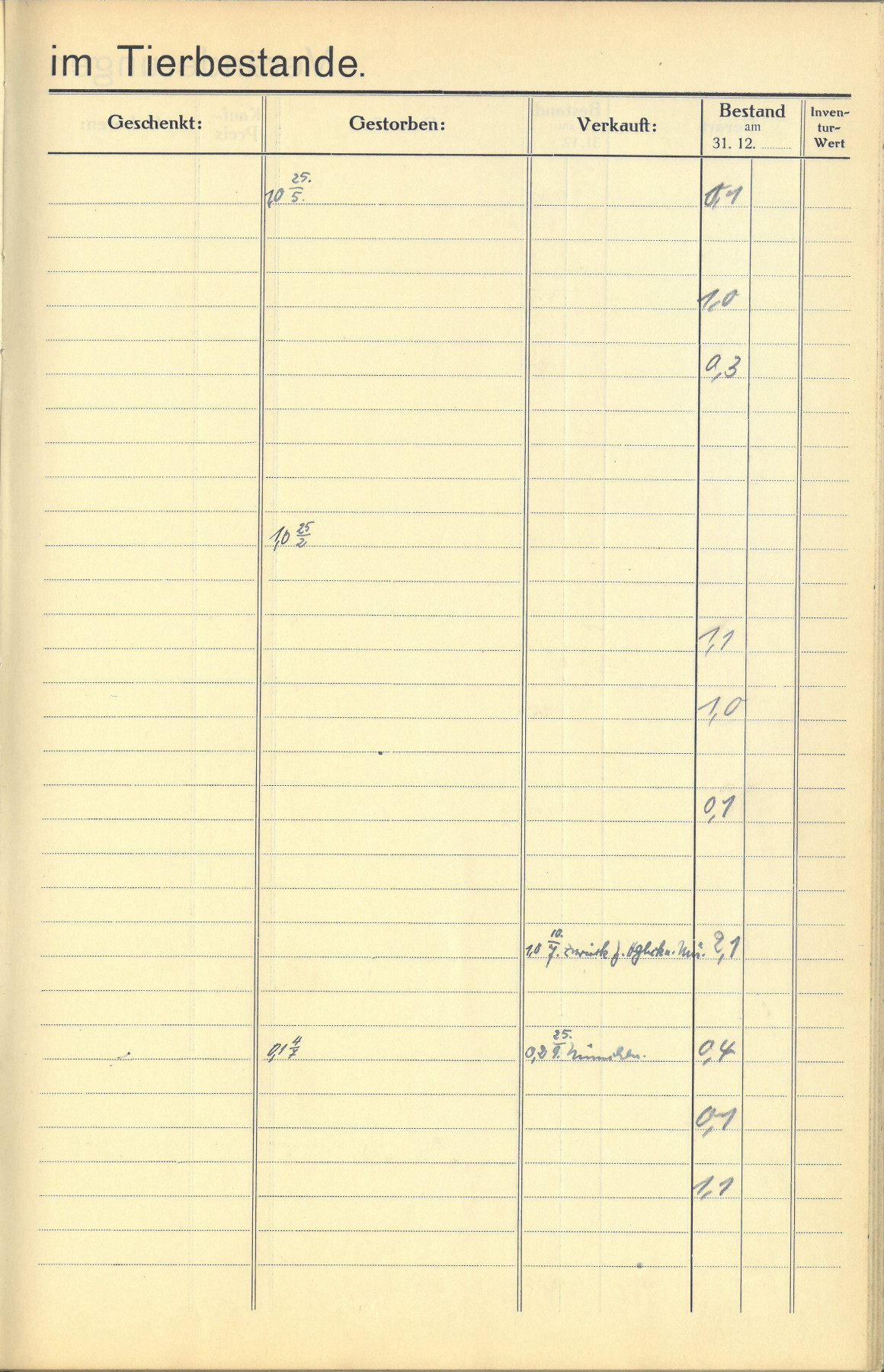

Extract from the journal for the year 1936. (AZGB. All rights reserved.)
The Berlin Zoological Garden houses what are known as the ‘Journale’, or journals, which – with a few exceptions – date back to the year 1888. We do not know whether this was the year in which this particular form of  animal directory was introduced, or whether older editions have simply not survived. In these journals, changes in animal stocks were listed for all animal species kept at the zoo, based on information from the bookkeeping department and reports from the different parts of the zoo, such as the animal houses and the adjoining enclosures for specific animal species. The population at the beginning of the year was recorded on the left-hand side, and all changes in the population over the year, up until the annual stocktake at the end of the year, were marked on the right. As with the
animal directory was introduced, or whether older editions have simply not survived. In these journals, changes in animal stocks were listed for all animal species kept at the zoo, based on information from the bookkeeping department and reports from the different parts of the zoo, such as the animal houses and the adjoining enclosures for specific animal species. The population at the beginning of the year was recorded on the left-hand side, and all changes in the population over the year, up until the annual stocktake at the end of the year, were marked on the right. As with the  Steinmetz Index, ‘1,0’ denotes a male, ‘0,1’ a female. Therefore, the numbers ‘1,1’ represent a pair consisting of one male and one female animal. The extract from the 1936 journal shown here lists three female – ‘0,3’ – chimpanzees at the beginning of the year. These were evidently joined by four more females – ‘0,4’ – on 2 July 1936. The animals were
Steinmetz Index, ‘1,0’ denotes a male, ‘0,1’ a female. Therefore, the numbers ‘1,1’ represent a pair consisting of one male and one female animal. The extract from the 1936 journal shown here lists three female – ‘0,3’ – chimpanzees at the beginning of the year. These were evidently joined by four more females – ‘0,4’ – on 2 July 1936. The animals were  purchased on a trip to Cameroon by Eva MacLean, who would later become the wife of zoo director
purchased on a trip to Cameroon by Eva MacLean, who would later become the wife of zoo director  Lutz Heck. One animal died shortly after arrival and two were given to the Munich zoo in September, leaving ‘0,4’ – four females – in the zoo’s animal stock at the end of the year.
Lutz Heck. One animal died shortly after arrival and two were given to the Munich zoo in September, leaving ‘0,4’ – four females – in the zoo’s animal stock at the end of the year.
Further, Eva MacLean’s shipment included a female  gorilla, which was joined by a male in the same year. The journal also records that this animal was purchased from the
gorilla, which was joined by a male in the same year. The journal also records that this animal was purchased from the  Hagenbeck company for 7,500 Reichsmark.
Hagenbeck company for 7,500 Reichsmark.
It was only in around 1925 that the journals began including information on the monetary value of the animals. This was recorded in a kind of  accounting inventory, in a separate volume for the same year. Subsequently, both pieces of information were recorded in the same journal. The journals only provide a partial history for a particular species at the zoo. They record the status quo and any deviations. Individual yearly reports do not provide enough information for us to gain a full understanding of the history of individual animals, or of a whole species in a given zoo. They rarely mention the
accounting inventory, in a separate volume for the same year. Subsequently, both pieces of information were recorded in the same journal. The journals only provide a partial history for a particular species at the zoo. They record the status quo and any deviations. Individual yearly reports do not provide enough information for us to gain a full understanding of the history of individual animals, or of a whole species in a given zoo. They rarely mention the  names that the public and the zoo gave to the animals. Depending on who was charged with keeping the journals for a given year, they might be more or less detailed, and might also include notes on buyers and sellers, prices,
names that the public and the zoo gave to the animals. Depending on who was charged with keeping the journals for a given year, they might be more or less detailed, and might also include notes on buyers and sellers, prices,  causes of death, or (in later journals) the monetary value assigned to the animal in the annual accounts. It is usually necessary to consult several journals in order to be able to answer questions about the history of a specific animal species kept at Berlin Zoo. For the 1920s and 1930s, researchers can consult what is called the
causes of death, or (in later journals) the monetary value assigned to the animal in the annual accounts. It is usually necessary to consult several journals in order to be able to answer questions about the history of a specific animal species kept at Berlin Zoo. For the 1920s and 1930s, researchers can consult what is called the  Steinmetz Index, which is more detailed for this period of time.
Steinmetz Index, which is more detailed for this period of time.